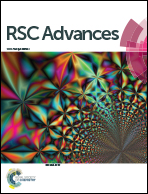Programming and use of Parylene C fluorescence as a quantitative on-chip reference†
Abstract
A large number of lab-on-a-chip applications use fluorescence for quantifying biological entities. In such applications, incorporation of a stable on-chip fluorescent reference source would be highly desirable in order to compensate for instrumental parameter variations, like for example non-constant illumination intensity over time. In this study, we exploit Parylene C that is used as a bonding layer material in a microfluidic chip. We first show programming of intermediate Parylene C bonding layer fluorescence (iPBLF) and its characterization as a function of the ultraviolet (UV) dose and Parylene C thickness. This technique requires no additional steps in the fabrication of the microfluidic chip and the fluorescence reference zones can simply be incorporated by local exposure to UV light after fabrication. Next, we demonstrate a fluorescence-based analyte concentration and flow-rate measurement in a microfluidic channel, under changing experimental conditions of illumination intensity and taking different microscope objectives. Sensing is realized by analyzing programmed reference and channel images by straightforward data handling using an open-source image processing tool. We anticipate that the demonstrated method will be a key technique allowing low complexity and reliable quantitative fluorescent measurements, for example in point-of-care and mobile diagnostic applications, where intensity calibration can present a major challenge.


 Please wait while we load your content...
Please wait while we load your content...